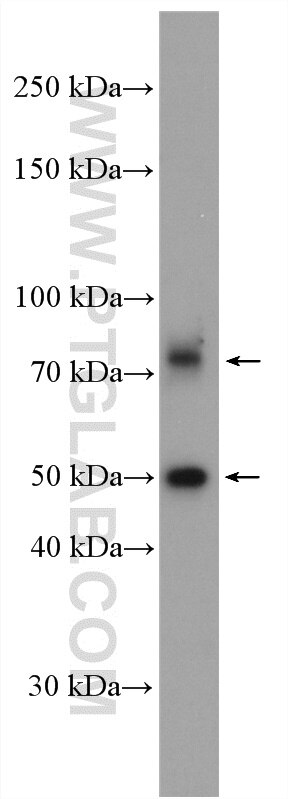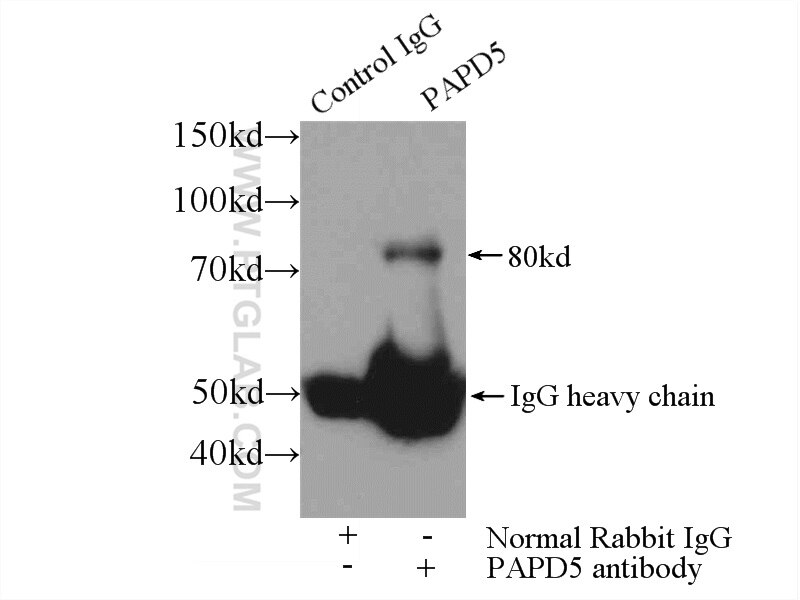- Phare
- Validé par KD/KO
Anticorps Polyclonal de lapin anti-PAPD5
PAPD5 Polyclonal Antibody for WB, IP, ELISA
Hôte / Isotype
Lapin / IgG
Réactivité testée
Humain, rat, souris
Applications
WB, IP, ELISA
Conjugaison
Non conjugué
N° de cat : 55197-1-AP
Synonymes
Galerie de données de validation
Applications testées
| Résultats positifs en WB | cellules HepG2, |
| Résultats positifs en IP | cellules Jurkat |
Dilution recommandée
| Application | Dilution |
|---|---|
| Western Blot (WB) | WB : 1:500-1:1000 |
| Immunoprécipitation (IP) | IP : 0.5-4.0 ug for 1.0-3.0 mg of total protein lysate |
| It is recommended that this reagent should be titrated in each testing system to obtain optimal results. | |
| Sample-dependent, check data in validation data gallery | |
Applications publiées
| KD/KO | See 1 publications below |
| WB | See 3 publications below |
Informations sur le produit
55197-1-AP cible PAPD5 dans les applications de WB, IP, ELISA et montre une réactivité avec des échantillons Humain, rat, souris
| Réactivité | Humain, rat, souris |
| Réactivité citée | Humain |
| Hôte / Isotype | Lapin / IgG |
| Clonalité | Polyclonal |
| Type | Anticorps |
| Immunogène | Peptide |
| Nom complet | PAP associated domain containing 5 |
| Masse moléculaire calculée | 64 kDa |
| Poids moléculaire observé | 63-80 kDa |
| Numéro d’acquisition GenBank | NM_001040285 |
| Symbole du gène | PAPD5 |
| Identification du gène (NCBI) | 64282 |
| Conjugaison | Non conjugué |
| Forme | Liquide |
| Méthode de purification | Purification par affinité contre l'antigène |
| Tampon de stockage | PBS with 0.02% sodium azide and 50% glycerol |
| Conditions de stockage | Stocker à -20°C. Stable pendant un an après l'expédition. L'aliquotage n'est pas nécessaire pour le stockage à -20oC Les 20ul contiennent 0,1% de BSA. |
Informations générales
PAPD5, also named as Non-canonical poly(A) RNA polymerase PAPD5, is a 572 amino acid protein, which contains 1 PAP-associated domain and belongs to the DNA polymerase type-B-like family. PAPD5 is predominantly expressed in the cytoplasm. PAPD5 as catalytic subunit of a TRAMP-like complex that has a poly(A) RNA polymerase activity and is involved in a post-transcriptional quality control mechanism. Polyadenylation with short oligo(A) tails is required for the degradative activity of the exosome on several of its nuclear RNA substrates. PAPD5 plays a role in replication-dependent histone mRNA degradation, probably through terminal uridylation of mature histone mRNAs. PAPD5 also may play a role in sister chromatid cohesion. The calculated molecular weight of PAPD5 is a 63 kDa, but the post-modified protein is about 70-80 kDa. PAPD5 exists some isoform with the molecular weight about 50 kDa and 70-80 kDa.
Protocole
| Product Specific Protocols | |
|---|---|
| WB protocol for PAPD5 antibody 55197-1-AP | Download protocol |
| IP protocol for PAPD5 antibody 55197-1-AP | Download protocol |
| Standard Protocols | |
|---|---|
| Click here to view our Standard Protocols |
Publications
| Species | Application | Title |
|---|---|---|
Nat Commun Mutant huntingtin induces neuronal apoptosis via derepressing the non-canonical poly(A) polymerase PAPD5 | ||
Nucleic Acids Res mRNAs are sorted for export or degradation before passing through nuclear speckles.
| ||
Nat Commun The MTR4/hnRNPK complex surveils aberrant polyadenylated RNAs with multiple exons |



